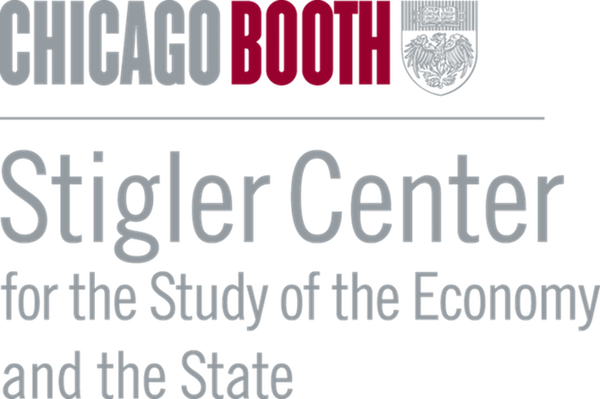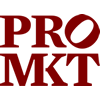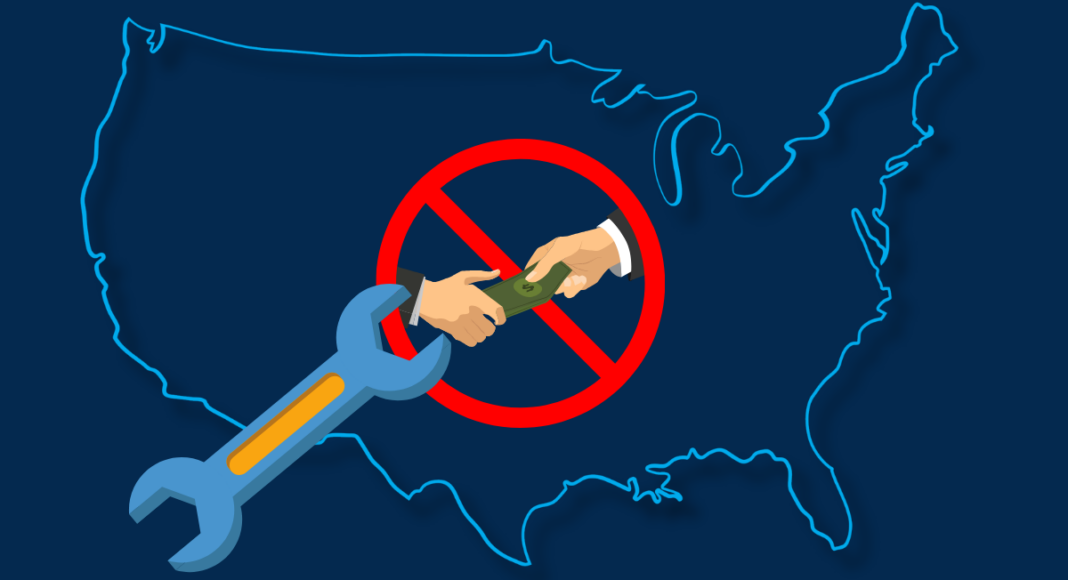Gary Kalman writes that actions under the second Trump administration to dismantle recent anti-corruption initiatives, including those pioneered during the first Trump administration, will cost dearly the American and global economy and enable many of the nefarious actors President Trump has publicly admonished.
ProMarket is publishing a series of articles in collaboration with Stanford University’s Program on Capitalism and Democracy. These articles are based on the conversations that occurred during the Program’s 2025 Global Capitalism, Trust, and Accountability Conference. You can visit their website for additional content.
Since January 2025, the Trump administration has issued executive orders, memoranda, and less official public declarations curtailing substantial aspects of the United States’ transnational anti-corruption regime. These include announcing the temporary suspension and subsequent narrowing of enforcement of the nation’s landmark foreign anti-bribery law; the dismantling of two anti-kleptocracy initiatives at the Department of Justice; the gutting of critical anti-money laundering laws, including the 2021 bipartisan Corporate Transparency Act; the reversal of sanctions on corrupt foreign officials; consideration of the misuse of sanctions against foreign judges who have ruled to hold corrupt foreign officials accountable; an intention to reduce oversight meant to prevent corruption-fueled diversion of arms sold overseas; the creation of a new “golden visa” that mirrors programs historically and notoriously abused by foreign oligarchs and kleptocrats; and a suspension of foreign aid, including aid targeted at combating corruption that undermines American economic and national security interests.
The hurricane-like destruction of the American transnational anti-corruption framework has serious, and not well understood, domestic and global implications. The consequences are especially egregious since the U.S. has been a historic and necessary leader in global anti-corruption enforcement.
Dating back to the 1970s with the passage of the Bank Secrecy Act and the Foreign Corrupt Practices Act, the U.S. has been at the vanguard in combating cross-border financial crime and corruption. This makes sense since the U.S.is the world’s largest economy and holder of the world’s reserve currency. More than half of all cross-border financial transactions use the U.S. dollar. Banks across the globe have correspondent relationships with our financial institutions that facilitate these transactions, giving our laws and enforcement practices global resonance.
The U.S. has also been more consistent and better resourced in the enforcement of its transnational anti-corruption laws. Consider that a 2022 Transparency International study, “Exporting Corruption,” found that of the 47 largest exporting countries—those with the most or largest multinational corporations—only the U.S. and Switzerland were actively enforcing their foreign anti bribery laws. Of the remaining 45 countries, the median number of new cases started in the four-year period reviewed from 2018 to 2021 was zero. And when, in 2023, the U.S. Congress passed the Foreign Extortion Prevention Act extending its foreign anti-bribery framework beyond covering just those who offer bribes to those who ask for them, the world took notice. Suddenly, corrupt foreign officials who enjoyed local impunity were faced with the possibility of prosecution by the U.S. DOJ.
Despite the progress in fighting transnational crime and corruption, the U.S. has had significant gaps in its anti-money laundering framework. Former U.S. Treasury Secretary Janet Yellen went so far as to say in a 2021 speech, “there’s a good argument that, right now, the best place to hide and launder ill-gotten gains is actually in the United States.” But just prior to that speech, the U.S. government had begun to address those gaps. In early 2021, during the final days of the first Trump administration, Congress passed the bipartisan Corporate Transparency Act to end the abuse of anonymous companies for corrupt and criminal purposes. Later that same year, Congress introduced with bipartisan support the ENABLERS Act to cover corporate service providers and other “gatekeepers” to the U.S. financial system. In subsequent years, the Biden administration adopted anti-money laundering rules to cover the real estate and private investment sectors.
Turning from this progress has consequences.
The current administration has made clear their prioritization of disrupting—even “eliminating”—drug cartels and transnational criminal organizations. The weakening of our anti-money laundering and cross-border anti-corruption rules undermines their ability to deliver on that promise.
A 2024 fact sheet from Transparency International U.S. identified multiple cases of the use of anonymous shell companies to hide and launder drug money in the United States. For example:
The Zheng drug trafficking organization—run by Chinese synthetic opioid trafficker Fujing Zheng— manufactured and shipped deadly fentanyl analogues and 250 other drugs to some 37 U.S. states, with drugs sold by the group directly tied to the fatal overdoses of two people in Ohio. The traffickers used shell companies formed in Massachusetts as they mailed, repackaged, and redistributed the drugs across the country.
Also,
The infamous Sinaloa Cartel relied on a criminal organization to organize the pickup of bulk cash proceeds from the sales of heroin and methamphetamine in Illinois, Nebraska, Massachusetts, New York, Maryland, North Carolina, Pennsylvania, and elsewhere in the United States before laundering the funds through a network of shell companies incorporated in Wyoming and overseen by a U.S. citizen in Arizona.
The lesson: you cannot stop what you cannot find. When “following the money,” law enforcement officials have said repeatedly that investigations die when they hit a wall of opacity. The narrowing of anti-money rules eliminates critical transparency.
Beyond the domestic impacts of dismantling transparency initiatives aimed at curtailing financial crime are the tangible national security impacts. A 2016 study from Global Witness, an organization that investigates the link between conflict and corruption, found numerous examples of the dangers of financial secrecy, including the following:
A U.S.-Afghan contractor funneled at least $3.3 million of U.S. taxpayer dollars to notorious Afghan power brokers, who deliberately hid their ownership interests in companies within the contractor’s network to avoid association with the insurgency. These individuals in turn funded the purchase of weapons for the Taliban and insurgents.
Undermining anti-money laundering checks could, once again, return us to a place where we inadvertently—due to hidden ownership of contracting entities— provide our adversaries with funds to purchase weapons to aim at our troops.
Beyond anecdotes, there are numerous studies that detail the use of financial secrecy to engage in corrupt and criminal activity. A 2011 study, “Puppet Masters,” by the Stolen Asset Recovery Initiative, a joint effort of the World Bank and United Nations Office on Drugs and Crime, found that anonymous companies were used to evade anti-money laundering laws and hide illicit proceeds in more than 70 percent of grand corruption cases reviewed over a 30-year period between 1980 and 2011.
Adding to the tragedy of anti-corruption policy demolition is the burgeoning body of evidence that these policies work. A Government Accountability Office report compared rates of losses to fraud and corruption following expenditures of emergency funding for Hurricanes Katrina and Sandy that hit the southwest U.S. in 2005 and northeast U.S. in 2012, respectively. The former relief effort had estimated losses between 10 and 22 percent. The latter: 2.7 percent. The difference was largely in the strength of the anti-corruption and anti-fraud measures in the authorizing legislation. Additionally, a resource guide produced by the Asian Pacific Economic Cooperation (APEC) cited research that showed that after the city of Guadalajara, Mexico instituted an online portal for business licensing and permitting, “bribe requests by municipal agents fell by 74% and bribe requests by third party license handlers fell by 85%.” Following release of the APEC findings, many businesses set aside their traditional skepticism of regulation and upped their interest in and support for anti-corruption protocols.
As the debate around these reforms continues, we must always keep top of mind that corruption is not a victimless crime and the measures to counter illicit finance are more than time-consuming paperwork exercises. As I have said before, bribes paid to building inspectors to ignore safety violations are later cited in catastrophic collapses. Bribes to officials to ignore worker standards result in disabling and lethal outcomes. Internationally, bribes have even helped divert weapons into the hands of rogue and dangerous actors.
In the end, strong transparency and accountability measures save money and lives. The dismissal and dismantling of the existing U.S. financial transparency framework takes all of us—the country and global economy—down a dangerous and costly path.
Author Disclosure: Gary Kalman is the executive director of Transparency International U.S., part of Transparency International. The fiscal sponsor for Transparency International U.S. is the Fund For Constitutional Government, whose donors for 2023 you can find here. Transparency International U.S.’ other large donors include Open Society Foundations, Transparency International (Secretariat in Berlin, Germany), Transparency International UK, Carnegie Corporation, Waverly Street Foundation, Humanity United, Chandler Foundation, Charles Davidson, and eQualitie Foundation. The author reports no conflicts of interest. You can read our disclosure policy here.
Articles represent the opinions of their writers, not necessarily those of the University of Chicago, the Booth School of Business, or its faculty.
Subscribe here for ProMarket’s weekly newsletter, Special Interest, to stay up to date on ProMarket’s coverage of the political economy and other content from the Stigler Center.






